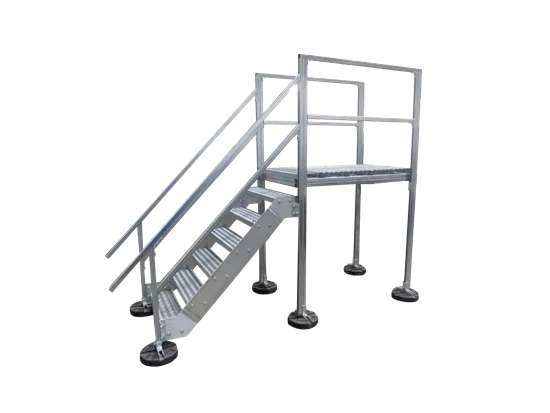
Stair platforms are essential tools in various Canadian workplaces, offering a safe and stable platform for reaching elevated areas. They come in various types, each with its strengths and applications:
1. Fixed Stair Platforms:
- Permanently installed: Ideal for frequently accessed areas.
- Comply with building codes: Ensure safety and meet regulations.
- Wide range of materials: Steel, aluminum, or fiberglass to suit different environments.
- Customization options: Platforms can be designed to specific needs, including size, shape, and railing configurations.
2. Mobile Stair Platforms:
- Portability: Easily moved to different locations within the workplace.
- Adjustable height: Adapt to various working heights.
- Rolling or stationary options: Choose based on the work environment.
- Applications: Ideal for maintenance, construction, and event setups.
3. Specialized Stair Platforms:
- Cantilever platforms: Extend from a wall, providing access to machinery or specific areas.
- Truck and trailer access platforms: Allow safe loading and unloading of vehicles.
- Portable work platforms: Offer a larger work surface and can be used for various tasks.
Finding the Right Stair Platform in Canada:
- Identify your needs: Consider platform height, weight capacity, portability requirements, and work environment.
- Consult with a reputable supplier: Ensure they offer platforms that meet Canadian safety standards and regulations.
- Look for certifications: Look for platforms certified by the Canadian Standards Association (CSA) or other relevant organizations.
Benefits of Using Stair Platforms:
- Increased safety: Reduce the risk of slips, trips, and falls compared to ladders.
- Improved efficiency: Provide a stable platform for working at elevated heights.
- Ergonomic benefits: Reduce worker fatigue and strain by offering a comfortable working position.
- Versatility: Can be used for various tasks and applications.
By choosing the right stair platform for your specific needs, you can ensure the safety and efficiency of your workers while complying with Canadian regulations.
FAQ
What are the platforms on stairs called?
The platforms on stairs are called landings. Landings are typically used to:
- Change the direction of the stairs.
- Provide a resting spot for users.
- Divide long flights of stairs into smaller sections for safety and code compliance.
What is the cheapest stair option?
Determining the cheapest stair option depends on several factors, including:
- Material: Wood is generally cheaper than metal or concrete. However, the specific type of wood used can significantly impact the cost.
- Complexity: Straight stairs are cheaper than stairs with turns or landings.
- Local regulations: Building codes may mandate specific materials or designs, impacting the cost.
What is the cheapest way to floor stairs?
The cheapest way to floor stairs often involves using:
- Carpet: While not the most durable option, it’s relatively inexpensive and easy to install yourself.
- Paint: Painting the existing treads can be cost-effective but may require proper preparation and may not be ideal for high-traffic areas.
How do you build stairs with platforms?
Building stairs with platforms requires specific construction knowledge and adherence to building codes. It’s generally recommended to consult a professional contractor to ensure the stairs are safe, meet code requirements, and are built to last. However, if you’re experienced in construction and familiar with building codes, you can find resources online or in libraries that detail the process of building stairs with platforms. Remember, safety is paramount, so proceed with caution and ensure you have the necessary expertise before attempting such a project yourself.
